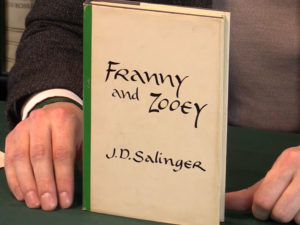Explore the complex world of the Glass family with J.D. Salinger’s “Franny and Zooey”. This intricate narrative weaves together spirituality, intellectualism, and family dynamics into a compelling tapestry. Stick around as we delve into a detailed summary, uncover fascinating facts, answer frequently asked questions, and explore the depth of this remarkable work.
Short Summary
“Franny and Zooey” comprises two related stories: “Franny”, a short story, and “Zooey”, a novella. In “Franny”, Franny Glass visits her boyfriend Lane Coutell for a football weekend but becomes increasingly disenchanted with the superficiality around her. She obsesses over a religious book about continuous prayer. In “Zooey”, Franny’s breakdown continues at her family’s Manhattan apartment. Her older brother Zooey tries to help her find a balance between spiritual quest and worldly responsibilities. Both stories explore the struggles of young, intellectually gifted characters grappling with the existential questions of meaning, faith, and personal authenticity.
Comprehensive Synopsis of “Franny and Zooey”
“Franny” – Introduction and Train Journey
Franny Glass travels by train to meet her boyfriend, Lane Coutell, for a Yale football weekend. Her disinterest and apprehension are evident from the start.
“Franny” – Lunch with Lane
Franny and Lane have lunch at a fancy restaurant. The conversation is strained; Lane talks about his academic achievements while Franny seems distant and disengaged.
“Franny” – The Jesus Prayer
Franny tells Lane about a religious book she’s been reading on the Jesus Prayer, a mantra meant to bring one closer to God. She’s obsessed with the idea but fails to explain it convincingly to Lane.
“Franny” – Emotional Breakdown
Franny experiences a breakdown, fainting in the restaurant. This event highlights her disillusionment with the world around her, including her relationship with Lane.
“Zooey” – Zooey in the Bath
The scene shifts to the Glass family apartment in New York. Zooey is reading a letter from his older brother Buddy while taking a bath. His mother, Bessie, interrupts him, and they discuss Franny’s emotional state.
“Zooey” – Bessie’s Concerns
Bessie is worried about Franny, who has returned home and is lying on the living room sofa in a semi-catatonic state. Zooey and Bessie argue about how best to help her.
“Zooey” – Franny’s Spiritual Crisis
Zooey talks to Franny about her use of the Jesus Prayer and questions her understanding of it. He criticizes her for using spirituality to escape from the complexities of life.
“Zooey” – The Phone Call
Zooey calls Franny, pretending to be their older brother Buddy. He offers her advice using insights he gained from their late brother Seymour. The conversation helps Franny make sense of her spiritual quest.
“Zooey” – Resolution and Understanding
Franny finds a sense of peace and understanding, partly due to Zooey’s counsel. The story closes with her resting, finally at ease, as Zooey watches over her.
Interesting Facts
Origin and Publication
- Two Separate Pieces: Initially, “Franny” and “Zooey” appeared as separate stories in The New Yorker magazine— “Franny” in 1955 and “Zooey” in 1957.
- Family Series: Both stories are part of Salinger’s series about the Glass family, a group of intellectually gifted siblings.
Literary Impact
- Critical Acclaim: The book was a commercial success, despite receiving mixed reviews from critics.
- Cultural Influence: The stories, especially their themes of spiritual quest and existential doubt, have influenced various other works and discussions on American spirituality.
Characters and Themes
- Glass Family: The characters Franny and Zooey are among the seven Glass siblings, who appear in various Salinger stories.
- Eastern Philosophy: The work incorporates ideas from Eastern philosophies and religions, reflecting Salinger’s own interests.
Behind the Scenes
- Personal Resonance: Salinger’s interest in spirituality and Eastern philosophy, especially Zen Buddhism, is strongly reflected in the text.
- Namesake: The character of Zooey is named after Russian writer Fyodor Dostoevsky, one of Salinger’s favorite authors.
Literary Techniques
- Dialogue-Heavy: The work is notable for its extensive use of dialogue to explore complex emotional and intellectual themes.
- Epistolary Element: The inclusion of a letter from Buddy Glass to Zooey serves as an unconventional narrative technique.
Reception and Interpretations
- Controversial Impact: Some critics have argued that the work reflects the spiritual emptiness of American culture, while others see it as a roadmap for spiritual questing.
- Academic Attention: The book is frequently studied in American literature courses and has spawned numerous scholarly articles.
Celebrity Fans: The book is known to have been a favorite of several famous personalities, including film director Wes Anderson, who cited it as an influence for his movie “The Royal Tenenbaums.”
Frequently Asked Questions
Why did Salinger choose to publish “Franny” and “Zooey” together?
Although originally published separately in “The New Yorker,” Salinger chose to combine “Franny” and “Zooey” into a single volume because the two stories are thematically interlinked. They offer complementary perspectives on existential angst and spiritual search, best appreciated when read together.
What is the significance of the Jesus Prayer in the story?
The Jesus Prayer serves as a central motif in “Franny,” representing her search for spiritual enlightenment and escape from worldly phoniness. However, her understanding of it is challenged by Zooey in the second part, highlighting the complexities of spiritual questing.
Who are the Glass siblings and why are they important?
The Glass siblings are a family of seven highly intelligent children who are often featured in Salinger’s works. Their intellectual and spiritual pursuits serve as a lens through which Salinger explores themes of existentialism, spirituality, and the human condition.
Why does the book focus so much on dialogue?
Salinger uses dialogue as a primary tool for character development and thematic exploration. The intense, often philosophical conversations between characters serve to illuminate their inner struggles and the book’s overarching themes.
Is the book autobiographical?
While not strictly autobiographical, “Franny and Zooey” contains elements that reflect Salinger’s own interests, particularly his fascination with Eastern philosophies and spirituality.
What is the book’s impact on American literature and culture?
“Franny and Zooey” has had a significant impact on American literature, especially in how it tackles themes of existential despair and spiritual questing. It has influenced various other works and remains a subject of academic study and cultural discussion.
Why do some readers find the characters unlikable?
The characters in “Franny and Zooey” are often critiqued for being overly intellectual and somewhat detached from ‘real-world’ problems, which some readers find off-putting. However, this characteristic is also what makes them compelling vehicles for the book’s complex themes.
🔥📚 Alright, Time to Sound Off! 📚🔥
So, what’s your take? Is Salinger a groundbreaking genius, or he’s just a highbrow scammer peddling intellectual melodrama? 🤯 Dive into the comment section!


Comments